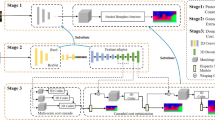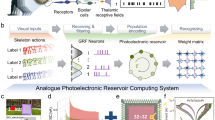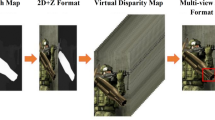Abstract
THE sensation of depth that is obtained with human binocular vision results from the differences in the projection of the world onto the two retinae. The process entails solving the problem of stereo correspondence, which involves choosing the correct matches between left and right image features. Many computational models of stereo vision assume a uniqueness constraint on stereo matching—that is, each feature identified in one image should eventually be matched with only one feature in the other image1,2. This constraint would seem to be justified, as allowing non-unique matches would be tantamount to supposing that the scene entities to which matches relate are in two places at once1. The value of the uniqueness constraint for eliminating false matches has been demonstrated in a variety of stereo algorithms. Yet on the basis of psychophysical results Weinshall3 concluded that it was not used by humans in dealing with certain types of ambiguous random-dot stereograms. We have now tested how Weinshall's stereograms are dealt with by PMF4, a stereo algorithm which uses a unique-matches selection procedure in conjunction with a purely local similar-disparity support scheme. We found that PMF produces results that are closely analogous to the psychophysical results. This suggests that Weishall's experiments should not be interpreted as evidence that the human stereo mechanism establishes non-unique matches.
This is a preview of subscription content, access via your institution
Access options
Subscribe to this journal
Receive 51 print issues and online access
$199.00 per year
only $3.90 per issue
Buy this article
- Purchase on SpringerLink
- Instant access to full article PDF
Prices may be subject to local taxes which are calculated during checkout
Similar content being viewed by others
References
Marr, D. & Poggio, T. Science 194, 283–287 (1976).
Mayhew, J. E. W. & Frisby, J. P. Artificial Intelligence 17, 349–386 (1981).
Weinshall, D. Nature 341, 737–739 (1989).
Pollard, S. B., Mayhew, J. E. W. & Frisby, J. P. Perception 14, 449–470 (1985).
Pollard, S. B., Porrill, J., Mayhew, J. E. W. & Frisby, J. P. Proc. 3rd Int. Symp. Robotics Research 19–26 (1985).
Burt, P. & Julesz, B. Perception 9, 671–682 (1980).
Prazdny, S. Biological Cybernetics 52, 93–99 (1985).
Krol, J. D. & van de Grind, W. A. Perception 9, 651–669 (1980).
Author information
Authors and Affiliations
Rights and permissions
About this article
Cite this article
Pollard, S., Frisby, J. Transparency and the uniqueness constraint in human and computer stereo vision. Nature 347, 553–556 (1990). https://doi.org/10.1038/347553a0
Received:
Accepted:
Published:
Issue date:
DOI: https://doi.org/10.1038/347553a0
This article is cited by
-
Hardware-friendly architecture for a pseudo 2D weighted median filter based on sparse-window approach
Multimedia Tools and Applications (2021)



